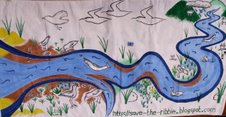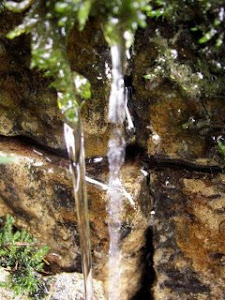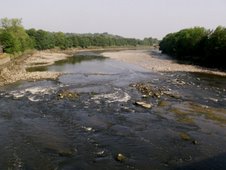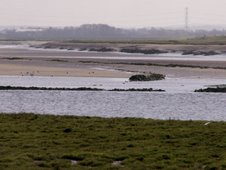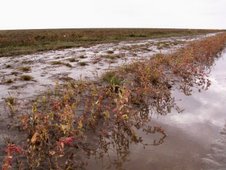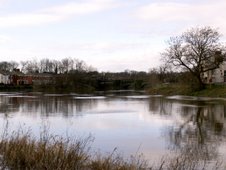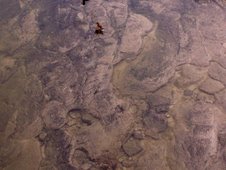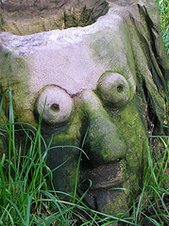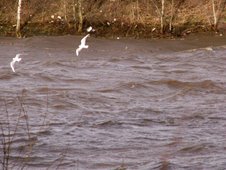
The tide was out and very low, the beautiful contours of the prehistoric riverbed clearly visible in the clear waters...

... large numbers of assorted Riversiders are out enjoying the peace and tranquillity of the Ribble riverbanks as we pass along the Penwortham Green Belt...

... and a large number of riversiders are right down by - and even in - the water, relaxing and playing as the Ribble's cool waters flow by...

...at Walton le Dale the Ribble's waters sparkle in the hot sunshine, and there are numerous birds singing all around...

...and we negotiate a passage through the other riverside residents who come over for a chat.
One of the many spectacular things this stretch of the Ribble - from the Shawes Arms at London Road (A6) right through to Brockholes and for miles beyond - are the huge numbers of Sand Martin colonies in the soft riverbanks. These graceful but incredibly fast birds are all around us, skimming over our heads and across the water catching small insects for their chicks...

...and all along the river we meet a variety of wildlife, all enjoying the range of habitats the Ribble provides, from fish moving lazily in the shallow pools or jumping for flies on the surface of the water, to birds flying overhead, or feeding and snoozing on the river...

The view up towards Brockholes at Mete House is glorious - and resonant of old paintings of the Ribble, showing how remarkably unspoilt the Ribble's valley is...


River Ribble circa 1862 by Thomas Lynch.
...we are lucky enough to catch glimpses of several Kingfishers all the way along the walk, although, like the Martins, Swallows, and Swifts, they are so difficult to catch on camera...

but if you click on this picture to enlarge it, you'll see a flash of blue where one is sitting in the bare branches above, on the right of the picture.
Out of the hot sunshine and into the dappled shade of Mellings Wood is a great pleasure...

...and out the other side we see a couple of Herons, one of whom is just as interested in us...

Once we reach the section of the Ribble Way which runs through the centre of the new reserve at Brockholes Wetland (Higher Brockholes Farm, as was), we are blown away by the vast numbers of Damselflies who are literally all around us...

We feel that this part of the Ribble Way should be renamed Damselfly Way!

We stop and sit on a grassy bank overlooking the largest lake on Brockholes Wetland (which is also the oldest of the quarried lakes here so its habitats are becoming well established).

We are surrounded by various caterpillars so have to be careful where we sit!

Brockholes Wetland is already a fantastic place, so it will be amazing when the Wildlife Trust have improved its habitats. This wetland is also bordered by the ancient woodlands of Red Scar Wood and Boilton Wood.

After a good long relaxing rest and the copious amounts of the water we brought along, studying the many insects, Damselflies - and even tiny furry creatures scuttling through the long grasses - we stir ourselves and head back downriver, knowing that the journey back home will be just as brilliant.

We pass back through Lower Brockholes Farm, a beautiful ancient farmland bordered by species-rich wet grasslands and the ancient deciduous woodlands of Brockholes Wood.


Speedwell glows amongst the long meadow grasses at Lower Brockholes Farm.
Unfortunately, however, this is the last days for Lower Brockholes Farm as it too is to be quarried for aggregate, so this landscape will soon change forever...

If its afteruse can also eventually complement the Ribble's wetland habitats, then it won't be so bad, so we hope that this will indeed be the case.
We pass other riversiders on the way back downriver too...

The Ribble is recovering from many years of misuse and pollution to become one of the best Salmon and Trout rivers in Britain,

and spawning pools in the numerous gravelly shallows of the riverbed are one of the reasons why.

In some areas these spawning pools have been deliberately recreated to make up for insensitive bankwork and dredging during past years - this pool, on the left of the far bank, has yet more Sand Martin colonies crowning the riverbanks above...

The Ribble is also steeped in history, and historic dwellings along the Ribble's banks include the 17th Century Cuerdale Hall, the site of the discovery of the Cuerdale Hoard of Viking treasure in 1840, and therefore evidence of a much older settlement at this spot.
The views along the Ribble valley are stunning in every direction, for miles and miles, and all within minutes walk of Preston city centre...

Downriver towards Mellings Wood...

and downriver towards Walton le Dale from the lower side of Mellings Wood at Mete House.
We decide to take the Ribble Way Cycle route from here, and where the river valley opens up towards Walton le Dale, the river is completely hidden from view once you move away from the riverbank path...

but again the views are priceless...

both on the macrocosmic scale...
...and the microcosmic...

This whole river floodplain is one of Nature's important wetland habitats, with both wetland grazing and drainage culverts offering diverse wetland wildlife habitats...

and a fabulous landscape for us to enjoy!

Long Live the Ribble Wild!
savetheribble@tiscali.co.uk
































